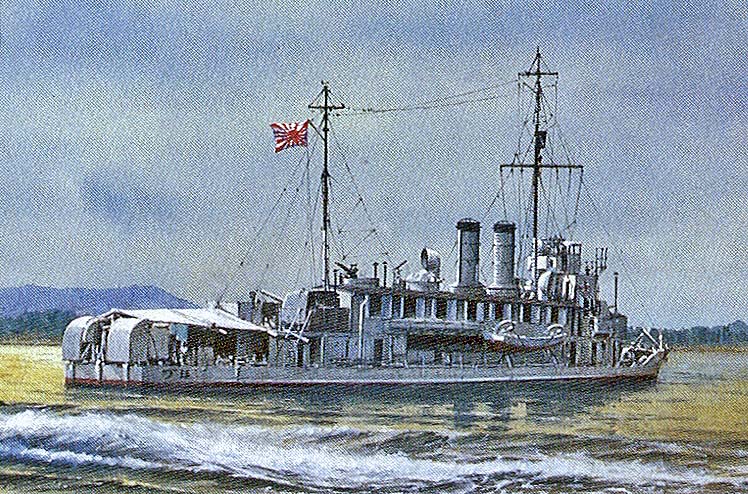©2007-2016 Bob Hackett, Sander Kingsepp and Peter Cundall
Revision 1
1557:
China. Portugual establishes a permanent settlement at the port of
Macau, then called Amagao.
1909:
Scotstoun, Great Britain. Gunboat MACAU is completed at Yarrow
Shipbuilders, then loaded aboard steamer SS GLENOCHY.
7 July 1909:
Hong Kong. GLENOCHY arrives at the British Crown Colony.
MACAU is lowered from the steamer's deck into Victoria Harbor.
21 July 1909:
Departs Hong Kong for the Portuguese colony of Macau.
Gunboat MACAU’s Commanding Officer is Primeiro-Tenente (Lt) Joaquim Anselmo da
Mata Oliveira.
19 July 1910:
MACAU, now under CO Major Alfredo Artur de Margalhaes,
lands a police company on Coloane, one of Macau's three islands. The police
rescue a number of Chinese children being held for ransom by pirates. MACAU's
crew receives gallantry awards from the Portuguese government for their actions.
1910-1941:
MACAU conducts patrols and surveys and maintains lights and
buoys. She travels down the Chinese coast providing safe passage for Portuguese
missionaries and shows the flag in Canton and other Chinese ports. MACAU
conducts exercises with other Portuguese warships and British, American and
French gunboats. Occasionally, she assists foundered vessels or those subjected
to pirate attacks.
7 July 1937: The Marco Polo Bridge (The"First China Incident") Incident:
Hun River, Peking (now Beijing), China. The Japanese discover a soldier
missing after night maneuvers at the bridge. They assume the Chinese captured
him and demand entry to a Peking suburb to look for him, but the Chinese refuse.
The Japanese then shell the city and an undeclared war begins.
12-21 October 1938:
Ta-Ya (Bias Bay), 35 miles NE of Hong Kong. At
dawn, LtGen Furusho Motoo’s 21st Army, supported by the China Area Fleet’s Fifth
Fleet and Formosa-based and carrier-based Navy air units, make a surprise
landing. Thereafter, Japanese forces continue their advance with little or no
resistance and by 21 October capture Canton. The operation isolates Hong Kong
and Macao.
8 December 1941:
MACAU is at Hong Kong. During World War II, Portugual
remains neutral. Macau provides safe haven for war refugees from China and Hong
Kong.
1943:
Governor (Navy Commander) Gabriel Maurício Teixeira's Colony of
Macau is bankrupt. Teixeira approves the sale of gunboat MACAU to the Japanese.
[1]
15 August 1943:
Renamed MAIKO and registered in the Sasebo Naval
District. Attached to Vice Admiral Soejima Daisuke's (38)(former CO of YAKUMO)
Second China Expeditionary Fleet of the China Area Fleet. Lt (later LtCdr)
Fukuchi Yoshi is appointed CO.
17-23 August 1943:
Hong Kong. MAIKO undergoes repairs at the No. 2
Repair Facility.
1 October 1943:
At Hong Kong.
6 October 1943:
Begins training.
20 November 1943:
MAIKO patrols the West River (Si Kiang) in the
vicinity of Hong Kong.
23 November 1943:
Departs Canton (now Guangzhou). Runs aground soon
thereafter.
3-23 June 1944:
Hong Kong. Undergoes repairs at the No. 2 Repair
Facility.
29 April 1945:
Reserve Lt Doi Masao is appointed CO.
9 September 1945:
Japanese troops in China formally surrender.
Canton. MAIKO is surrendered and taken over by the Chinese Nationalist's
Republic of China Navy. Renamed WU FENG.
30 September 1945:
Removed from the Navy List.
1949:
After the Chinese revolution, WU FENG is captured by the navy of
the Communist People’s Liberation Army (PLA).
Early 1960s:
Discarded.
Authors' Notes:
[1] One report indicates the Japanese seized MACAU, rather
than purchased her.
Thanks go to Dr. Higuchi Tatsuhiro and "Fontessa" of Japan and to Matt
Jones of the USA.
-Bob Hackett, Sander Kingsepp and Peter Cundall
Back to
Gunboat Page



